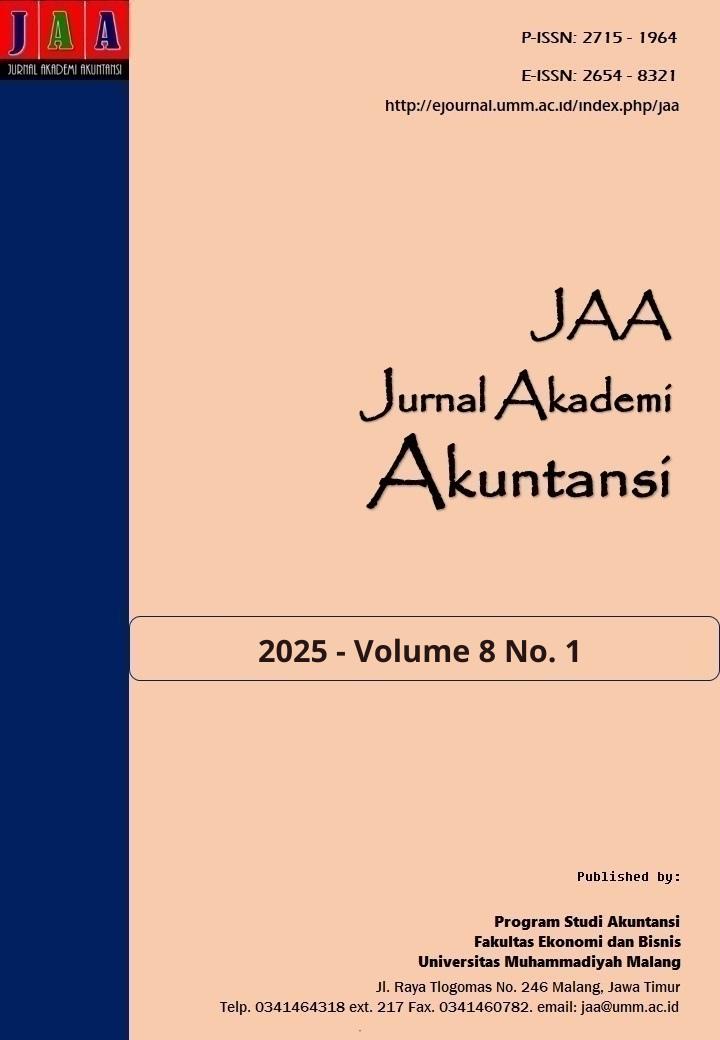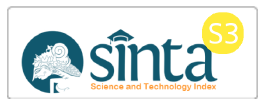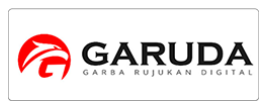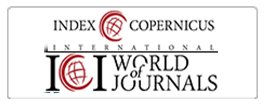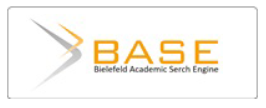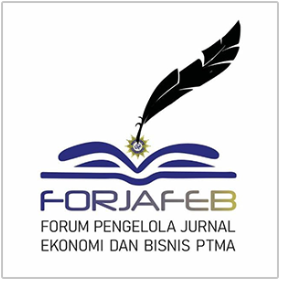Determinants of tax avoidance disclosure moderated by firm size
DOI:
https://doi.org/10.22219/jaa.v8i1.37310Keywords:
Firm Size, Inventory Turnover, Profitability, Sales Growth, Tax AvoidanceAbstract
Purpose: This study aims to analyze the effect of sales growth, profitability, and inventory turnover on tax avoidance moderated by firm size.
Methodology/approach: This study uses secondary data from firm financial statements in a quantitative research approach. Companies in the real estate and property sectors that are listed on the Indonesia Stock Exchange (IDX) between 2020 and 2023 make up the population. 34 samples in all were chosen using a purposive selection technique, and moderated regression analysis (MRA) was performed using EViews software.
Findings: The study's findings show that while profitability and inventory turnover significantly reduce tax avoidance, sales growth has little influence on the practice. Firm size can minimize the impact of profitability on tax avoidance, but it has no influence on the link between sales growth and inventory turnover and tax avoidance.
Practical and Theoretical contribution/Originality: It is anticipated that the Directorate General of Taxes will use the findings from this study as a guide when evaluating corporate tax evasion. It also explains how business size influences the relationship between tax avoidance and inventory turnover, profitability, and sales growth.
Research Limitation: Because businesses have not been consistent in releasing financial reports over the 2020–2023 timeframe, and because the metrics are restricted to proxies for firm size, sales growth, profitability, and inventory turnover, this study has a narrow focus. Additionally, only publicly available secondary data specifically, financial reports are used in data collecting.
Downloads
References
Abdullah, M. W., Jupaing, J., Anwar, P. H., & Hanafie, H. (2021). Mining Companies Tax Avoidance Investigation by the Company Characteristics and CSR: Company Size as the Moderating Variable. Jurnal Minds: Manajemen Ide Dan Inspirasi, 8(1), 29. https://doi.org/10.24252/minds.v8i1.20250
Ainniyya, S. M., Sumiati, A., & Susanti, S. (2021). Pengaruh Leverage, Pertumbuhan Penjualan, dan Ukuran Perusahaan Terhadap Tax Avoidance. Owner, 5(2), 525–535. https://doi.org/10.33395/owner.v5i2.453
Alpi, M. F. (2018). Pengaruh Debt To Equity Ratio, Inventory Turn Over, Dan Current Ratio terhadap Return On Equity pada Perusahaan Sektor Farmasi Yang Terdaftar Di Bursa Efek Indonesia. The National Conference on Management and Business (NCMAB), 158–175.
Andini, R., Andika, A. D., & Pranaditya, A. (2021). Analisa Pengaruh Kepemilikan Institusional, Proporsi Dewan Komisaris Independen, dan Profitabilitas terhadap Penghindaran Pajak dengan Ukuran Perusahaan sebagai Variabel Moderating (Studi Empiris Pada Industri Barang Konsumsi yang Terdaftar di Bursa Efek . Jurnal Akuntansi Dan Pajak, 22(2), 511. https://doi.org/10.29040/jap.v22i2.3193
Ariska, M., Fahru, M., & Kusuma, J. W. (2020). Leverage, Ukuran Perusahaan dan Profitabilitas dan Pengaruhnya Terhadap Tax Avoidance Pada Perusahaan Sektor Pertambangan di Bursa Efek Indonesia Tahun 2014-2019. Jurnal Revenue : Jurnal Ilmiah Akuntansi, 1(1), 133–142. https://doi.org/10.46306/rev.v1i1.13
Astuti, D. F., Dewi, R. R., & Fajri, R. N. (2020). Pengaruh Corporate Governance dan Sales Growth terhadap Tax Avoidance di Bursa Efek Indonesia (BEI) 2014-2018. Ekonomis: Journal of Economics and Business, 4(1), 210. https://doi.org/10.33087/ekonomis.v4i1.101
Augustpaosa Nariman, J. J. T. (2021). Faktor-Faktor Yang Mempengaruhi Tax Avoidance Perusahaan Manufaktur Yang Terdaftar Di BEI. Jurnal Paradigma Akuntansi, 3(4), 1498. https://doi.org/10.24912/jpa.v3i4.14966
Aulia, N., & Purwasih, D. (2022). Pengaruh Kepemilikan Institusional Dan Capital Intensity Terhadap Tax Avoidance Dengan Ukuran Perusahaan Sebagai Variabel Moderasi. Jurnal Revenue : Jurnal Ilmiah Akuntansi, 3(2), 395–405. https://doi.org/10.46306/rev.v3i2.156
Awaliah, R., Ayu Damayanti, R., & Usman, A. (2022). Tren Penghindaran Pajak Perusahaan di Indonesia yang Terdaftar di BEI (Tahun 2016-2020) Melalui Analisis Tingkat Effective Tax Rate (ETR) Perusahaan. Akrual: Jurnal Bisnis Dan Akuntansi Kontemporer, 1(1), 1–11. https://doi.org/10.26487/akrual.v15i1.20491
Ayustina, A., & Safi’i, M. (2023). Pengaruh Sales Growth, Karakter Eksekutif, Dan Capital Intensity Terhadap Tax Avoidance. Jurnal Akuntansi, Bisnis Dan Ekonomi Indonesia (JABEI), 2(1), 141–149. https://doi.org/10.30630/jabei.v2i1.109
Chandra, Y., & Oktari, Y. (2022). Pengaruh Sales Growth, Profitabilitas, Ukuran Perusahaan, Dan Karakteristik Eksekutif Terhadap Tax Avoidance (Studi Empiris Pada Perusahaan Manufaktur Yang Terdaftar Di Bursa Efek Indonesia). Akuntoteknologi : Jurnal Ilmiah Akuntansi Dan Teknologi, 13(2), 1–16. https://doi.org/10.31253/aktek.v13i2.872
Dewi, N. K. K., & Merkusiwati, N. K. L. A. (2023). Ukuran Perusahaan Memoderasi Pengaruh Profitability dan Capital Intensity terhadap Tax Avoidance. E-Jurnal Akuntansi, 33(8), 2145–2159. https://doi.org/10.24843/eja.2023.v33.i08.p13
Fatimah, N., & Nurdin, F. (2024). The Role of Institutional Ownership as A Moderating Variable in Determining Disclosure of Tax Avoidance (Mining Sector Companies 2018-2022). 22(1), 1–14. https://doi.org/10.24167/jab.v22i1.11181
Hamdani, D., & Prastiyanti, T. (2022). The Impact of Return on Asset, Debt to Equity Ratio and Inventory Turnover on Effective Tax Rate with Financial Distress as Intervening Variable (Case Study on Textile and Garment Sub-Sector Companies Listed on the Indonesia Stock Exchange 2013-2020). Journal of Accountancy Inaba, 01(01).
Harnik, I. D. (2019). Pengaruh Ukuran Perusahaan, Kepemilikan Institusional, Komisaris Independen, Dan Karakter Eksekutif Terhadap Tax Avoidance Pada Perusahaan Manufaktur Yang Terdaftar Di Bei Tahun 2015-2018. E-Jurnal Universitas Atma Jaya Yogyakarta, 1–15. http://e-journal.uajy.ac.id/24655/1/JURNAL.pdf
Hendayana, Y., Arief Ramdhany, M., Pranowo, A. S., Abdul Halim Rachmat, R., & Herdiana, E. (2024). Exploring impact of profitability, leverage and capital intensity on avoidance of tax, moderated by size of firm in LQ45 companies. Cogent Business and Management, 11(1). https://doi.org/10.1080/23311975.2024.2371062
Hermanto, H., & Puspita, I. (2022). Pengaruh perputaran persediaan, Capital Intensity, dan Leverage terhadap Tax Avoidance dengan ukuran perusahaan sebagai variabel moderasi. Fair Value: Jurnal Ilmiah Akuntansi Dan Keuangan, 5(2), 1186–1194. https://doi.org/10.32670/fairvalue.v5i2.2121
Hermawan, S., Sudradjat, S., & Amyar, F. (2021). Pengaruh Profitabilitas, Leverage, Ukuran Perusahaan Terhadap Tax Avoidance Perusahaan Property dan Real Estate. Jurnal Ilmiah Akuntansi Kesatuan, 9(2), 359–372. https://doi.org/10.37641/jiakes.v9i2.873
Hidayah, N. (2024). Pengaruh Leverage, Ukuran Perusahaan, Profitabilitas, dan Intensitas Modal terhadap Penghindaran Pajak melalui Tata Kelola Perusahaan sebagai Variabel Moderasi (Studi pada Perusahaan Manufaktur Subsektor Makanan dan Minuman yang Terdaftar di Bursa Efek In. Innovative Technologica: Methodical Research Journal, 1(2), 15. https://doi.org/10.47134/innovative.v1i2.64
Hutapea, I. V. R., & Herawaty, V. (2020). Pengaruh Manajemen Laba, Leverage Dan Profitablitas Terhadap Tax Avoidance Dengan Ukuran Perusahaan Sebagai Variabel Moderasi (Studi Empiris Pada Perusahaan Sektor Manufaktur Yang Terdaftar Di Bursa Efek Indonesia 2016 – 2018). Prosiding Seminar Nasional Pakar, 1–10. https://doi.org/10.25105/pakar.v0i0.6840
Jensen, M. C., & Meckling, W. H. (1976). Theory of the firm: Managerial behavior, agency costs and ownership structure. Corporate Governance: Values, Ethics and Leadership, 77–132. https://doi.org/10.4159/9780674274051-006
Kartikaningdyah, E. (2019). The Effect of Firm Size, ROA and Executive Character on Tax Avoidance. 377(Icaess), 117–124. https://doi.org/10.2991/icaess-19.2019.23
Kementerian Keuangan. (2023). Informasi APBN 2023 Peningkatan Produktivitas untuk Transformasi Ekonomi yang Inklusif dan Berkelanjutan. Media Kementian Keuangan, 1–23. https://media.kemenkeu.go.id/getmedia/6439fa59-b28e-412d-adf5-e02fdd9e7f68/Informasi-APBN-TA-2023.pdf?ext=.pdf
Lestiowati, R. (2018). Analisis Perputaran Persediaan dan Perputaran Piutang terhadap Profitabilitas (Studi Empiris Pada Perusahaan Sektor Makanan DanMinuman Yang Terdaftar Di Bursa Efek Indonesia Tahun 2014-2016). Jurnal Akuntansi, 6(1), 25–39. https://doi.org/10.24964/ja.v6i1.562
Mariadi, M. D., & Dewi, L. G. K. (2022). Pengaruh Leverage, Profitabilitas, dan Intensitas Aset Tetap terhadap Tax Avoidance pada Perusahaan Manufaktur di BEI. JIMAT Universitas Pendidikan Ganesha, 13(4), 1136–1140.
Mariani, N. A. (2024). Analysis of the Influence of Capital Intensity , Inventory Turnover ( ITO ) and Return on Assets ( ROA ) on the Effective Tax Rate ( Etr ) with Institutional Ownership as a Moderating Variable. 5(10), 4665–4674.
Misral, M., Rahmayanti, S., & Sari, D. A. (2020). Pengaruh Inventory Turn Over, Returm on Assets dan Debt to Assets Ratio Terhadap Tax Avoidance pada Perusahaan Manufaktur di BEI Tahun 2013-2017. Jurnal Akuntansi Dan Ekonomika, 10(1), 51–60. https://doi.org/10.37859/jae.v10i1.1931
Muliana, S., & Supryadi, S. (2023). Pengaruh Profitabilitas Dan Leverage Terhadap Tax Avoidance. Patria Artha Journal of Accounting & Financial Reporting, 7(1), 1–14. https://doi.org/10.33857/jafr.v7i1.685
Nanningsih, D., & Dewi, R. D. (2022). The_Effect_of_Sales_Growth_Leverage_and_Profitabil. https://doi.org/http://dx.doi.org/10.21070/acopen.8.2023.3779
Natalina. (2023). The Effect of Profitability, Corporate Governance, Inventory Intensity on Tax Avoidance (in Mining Companies listed on the Indonesia Stock Exchange for the period 2017-2021). International Journal of Science and Society, 5(5), 25–38. https://doi.org/10.54783/ijsoc.v5i5.865
Noveliza, D., & Crismonica, S. (2021). Faktor Yang Mendorong Melakukan Tax Avoidance. Mediastima, 27(2), 182–193. https://doi.org/10.55122/mediastima.v27i2.293
Nugraha, C. D. (2020). The Influence of Inventory Turnover, Independent Commissioners, Profitability and Company Size on Tax Aggressivity. Accounting Journal Indonesian College of Economics.
Prabowo, A., & Sahlan, R. (2022). Pengaruh Profitabilitas, leverage, dan Capital Intensity terhadap Penghindaran Pajak dengan Ukuran Perusahaan sebagai Variabel (Moderating) (Studi Empiris pada Perusahaan Manufaktur yang Terdaftar di BEI Tahun 2015-2019). Media Akuntansi Perpajakan, 6(2), 55–74. https://doi.org/10.52447/map.v6i2.5126
Pucantika, N. R. P., & Wulandari, S. (2022). Pengaruh Kompensasi Manajemen, Profitabilitas, Capital Intensity, dan Leverage Terhadap Tax Avoidance. Kompak :Jurnal Ilmiah Komputerisasi Akuntansi, 15(1), 14–24. https://doi.org/10.51903/kompak.v15i1.587
Puspita, I., & Hermanto. (2022). Pengaruh Perputaran Persediaan, Capital Intensity, dan Leverage Terhadap Tax Avoidance Dengan Ukuran Perusahaan Sebagai Variabel Moderasi. Fair Value : Jurnal Ilmiah Akuntansi Dan Keuangan, 5(2), 1186–1194. https://doi.org/10.32670/fairvalue.v5i2.2121
Ramadani, S., & Tanno, A. (2022). Pengaruh Profitabilitas, Leverage dan Capital Intensity terhadap penghindaran pajak dengan ukuran perusahaan sebagai variabel moderasi. Syntax Literate : Jurnal Ilmiah Indonesia, 7(12), 19975–19994. http://dx.doi.org/10.36418/syntax-literate.v7i12.11617
Ristanti, L. (2022). Corpporate Social Responsibility, Capital Intensity, Kualitas Audit Dan Penghindaran Pajak: Kepemilikan Institusional Sebagai Variabel Moderasi. Jurnal Literasi Akuntansi, 2(1), 50–62. https://doi.org/10.55587/jla.v2i1.22
Rizka, N. R., & Rahayu, R. M. (2023). Does Firm Size Moderating Influence Of Sales Growth On Tax Avoidance ? JAK (Jurnal Akuntansi) Kajian Ilmiah Akuntansi, 10(2), 310–322. https://doi.org/10.30656/jak.v10i2.5526
Rosandi, A. D. (2022). Pengaruh Profitabilitas, Inventory Intensity Terhadap Tax Avoidance Dengan Kepemilikan Institusional Sebagai Pemoderasi. Jurnal Akuntansi STIE Muhammadiyah Palopo, 8(1), 19. https://doi.org/10.35906/jurakun.v8i1.961
Safitri, N., & Damayanti, T. W. (2021). Sales Growth dan Tax Avoidance dengan Kepemilikan Institusional Sebagai Variabel Pemoderasi. Perspektif Akuntansi, 4(2), 175–216. https://doi.org/10.24246/persi.v4i2.p175-216
Saputra, Suwandi, S. (2020). Pengaruh Leverage Dan Capital Intensity Terhadap Tax Avoidance Dengan Ukuran. ISAFIR; Islamic Accounting and Finance Review, 1, 29–47. https://doi.org/10.24252/isafir.v1i2.17587
Suyanto, S., & Kurniawati, T. (2022). Profitabilitas, Pertumbuhan Penjualan, Leverage, Penghindaran Pajak: Ukuran Perusahaan Sebagai Variabel Moderasi. Jurnal Manajemen Terapan Dan Keuangan, 11(04), 820–832. https://doi.org/10.22437/jmk.v11i04.16725
Ulinuha, U., & Nurdin, F. (2024). Jurnal E-Bis : Ekonomi Bisnis Ukuran Perusahaan Memoderasi Profitabilitas , Leverage , Capital Intensity ,. 8(2), 520–538.
Wahyuni, A. D., Mulyadi, & Sianipar, panata bangar hasioan. (2023). Pengaruh Sales Growth dan Intensitas Modal Terhadap Tax Avoidance dengan Kepemilikan Institusional sebagai Variabel Moderasi pada Perusahaan Sektor Barang Baku yang Terdaftar di Bursa Efek Indonesia Periode 2018-2021. Inisiatif: Jurnal Ekonomi, Akuntansi Dan Manajemen, 2(4), 293–309. https://doi.org/10.30640/inisiatif.v2i4.1438
Winarta, P., Siburian, M. E., & Noviyanti, E. (2024). Effect of sales growth , capital intensity and debt to equity ratio on tax avoidance as moderated by firm size. 5(4).
Downloads
Published
Issue
Section
License
Copyright (c) 2024 Nihayatul Maula Sari, Fajar Nurdin

This work is licensed under a Creative Commons Attribution-NonCommercial-ShareAlike 4.0 International License.
Jurnal Akademi Akuntansi is licensed under a Creative Commons Attribution-NonCommercial-ShareAlike 4.0 International License.
Authors who publish with this journal agree to the following terms:
- Authors retain copyright and grant the journal right of first publication with the work simultaneously licensed under a Creative Commons Attribution-NonCommercial-ShareAlike 4.0 International License that allows others to share the work with an acknowledgment of the work's authorship and initial publication in this journal.
- Authors are able to enter into separate, additional contractual arrangements for the non-exclusive distribution of the journal's published version of the work (e.g., post it to an institutional repository or publish it in a book), with an acknowledgment of its initial publication in this journal.
- Authors are permitted and encouraged to post their work online (e.g., in institutional repositories or on their website) prior to and during the submission process, as it can lead to productive exchanges, as well as earlier and greater citation of published work (See The Effect of Open Access).
Jurnal Akademi Akuntansi dilisensikan di bawah lisensi Creative Commons Attribution-NonCommercial-ShareAlike 4.0 International.
Penulis yang menerbitkan artikel di jurnal ini menyetujui ketentuan berikut:
- Penulis mempertahankan hak cipta dan memberikan hak jurnal atas publikasi pertama dengan karya yang secara serentak dilisensikan di bawah Lisensi Pengaitan Creative Commons yang memungkinkan orang lain untuk berbagi karya dengan pengakuan atas karya penulis dan publikasi awal dalam jurnal ini.
- Penulis dapat masuk ke dalam pengaturan kontrak tambahan yang terpisah untuk distribusi non-eksklusif versi karya jurnal yang diterbitkan (misalnya, mempostingnya ke repositori institusional atau mempublikasikannya dalam sebuah buku), dengan pengakuan publikasi awalnya di jurnal ini.
- Penulis diizinkan dan didorong untuk memposting pekerjaan mereka secara online (misalnya, di repositori institusional atau di situs web mereka) sebelum dan selama proses pengajuan, karena dapat mengarah pada pertukaran produktif, serta kutipan pekerjaan sebelumnya dan yang lebih besar (Lihat Pengaruh Akses Terbuka).

